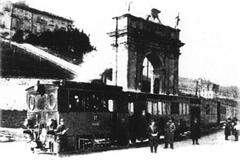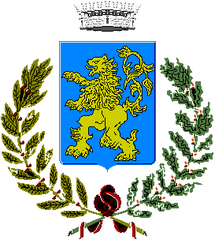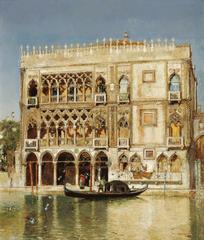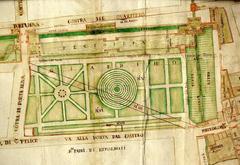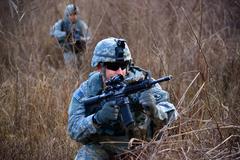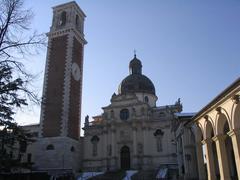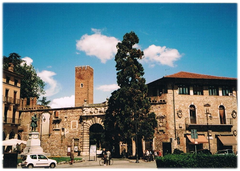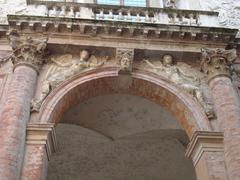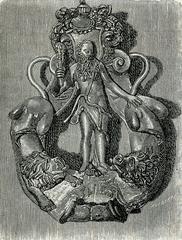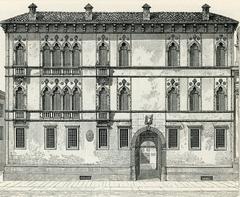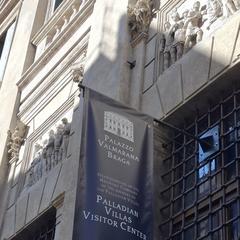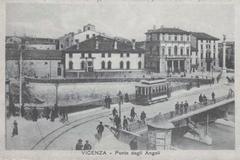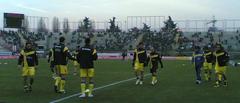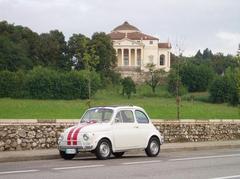
Porta Santa Lucia Vicenza Italy: Visiting Hours, Tickets, and Historical Sites Guide
Date: 03/07/2025
Introduction
Porta Santa Lucia, located at the western edge of Vicenza’s historic center, stands as a prominent symbol of the city’s medieval and Renaissance legacy. As a once-vital defensive gate, it protected Vicenza through centuries of political changes, serving both as a military fortification and a civic emblem. Today, the gate invites visitors to experience the city’s storied past through its robust architecture and vibrant surrounding neighborhoods. This guide offers a detailed exploration of Porta Santa Lucia’s history, architectural significance, visiting information, and nearby attractions, ensuring travelers get the most out of their visit to one of Vicenza’s most treasured historical sites (VicenzaNews; Italy Heritage; piccoliesploratori.com; PlanetWare).
Table of Contents
- Early Defensive Structures and Medieval Foundations
- Scaligeri Period and the Rise of Porta Santa Lucia
- Venetian and Visconti Influence: 14th–15th Centuries
- Architectural Features and Urban Integration
- Porta Santa Lucia in Vicenza’s Urban Evolution
- Cultural and Strategic Significance
- Visitor Information: Hours, Tickets, and Accessibility
- Nearby Attractions and Amenities
- Visitor Experience and Practical Tips
- Frequently Asked Questions (FAQ)
- Conclusion
- References
Early Defensive Structures and Medieval Foundations
The roots of Vicenza’s fortifications trace back to the early Middle Ages. The city, situated where the Astico and Retrone rivers meet, benefited from natural defenses and elevated terrain. During the 10th to 12th centuries, as Vicenza’s strategic and economic importance grew, city walls and castles were ordered by Berengario I and Emperor Conrad II, with the local bishop overseeing their construction (VicenzaNews).
The medieval walls encircled the city with major gates—Porta Feliciana, Porta Nova, Porta Pusterla, Porta S. Pietro, and Porta Berga—each reinforced by towers, drawbridges, and a moat supplied by the Bacchiglione and Seriola rivers. These early defenses laid the groundwork for the later expansion and construction of significant gates like Porta Santa Lucia.
Scaligeri Period and the Rise of Porta Santa Lucia
The most transformative period for Vicenza’s defenses came under the Scaligeri (Della Scala family) in the 14th century. Following the fall of Ezzelino III da Romano, the Scaligeri conducted a comprehensive reinforcement and expansion of the city’s walls, enclosing new suburbs and constructing principal gates, including Porta Santa Lucia (VicenzaNews).
Built between 1311 and 1387, Porta Santa Lucia became a vital western gateway, supporting the city’s growth while providing a formidable defense. The Scaligeri’s architectural legacy is evident in the sturdy masonry, crenellations, and defensive towers that defined the city’s perimeter.
Venetian and Visconti Influence: 14th–15th Centuries
Vicenza experienced significant changes in the late Middle Ages, oscillating between Visconti and Venetian control. Under the Visconti (1387–1404), fortifications were maintained and improved. When Vicenza pledged allegiance to the Republic of Venice in 1405, the city’s status as a frontier stronghold prompted further investment in its defenses. Venetian authorities fortified key boroughs and reinforced existing structures, with innovations such as cylindrical towers designed to resist artillery (Italy Heritage).
Porta Santa Lucia remained crucial, serving both defensive and administrative roles during the Venetian era, reflecting the evolution of military technology and urban planning.
Architectural Features and Urban Integration
Porta Santa Lucia is an exemplar of medieval military architecture, featuring robust stonework, a defensible passageway, and a commanding tower. The gate is crowned by a bas-relief of the Lion of Saint Mark, symbolizing Vicenza’s centuries under Venetian rule (piccoliesploratori.com). The adjacent tower also bears historical significance, having witnessed fighting during the Risorgimento in 1848 (vicenzanews.it).
The gate is seamlessly integrated into the city’s urban fabric, marking a transition from the historic city center to the expanding neighborhoods that developed beyond the walls.
Porta Santa Lucia in Vicenza’s Urban Evolution
Over the centuries, Porta Santa Lucia has remained a key point of entry and a symbol of continuity for the city. The area within the gate, Contrà Mure Santa Lucia, is characterized by narrow streets and artisan workshops, preserving the city’s medieval character (piccoliesploratori.com).
Nearby, the Borgo Santa Lucia district evolved as a vibrant suburb with a mix of residential, religious, and institutional buildings, including the historic Seminario Maggiore (vicenzanews.it).
Cultural and Strategic Significance
Historically, Porta Santa Lucia was more than a defensive gate; it symbolized the city’s openness, civic pride, and resilience. It was the site of ceremonial entries, military parades, and civic gatherings. During the Venetian era, the gate played an integral part in regulating trade and facilitating communication, anchoring the community to its past (PlanetWare; Not About the Miles).
Visitor Information: Hours, Tickets, and Accessibility
- Visiting Hours: Porta Santa Lucia is an outdoor, public monument accessible 24/7. The best times to visit are during daylight hours, from 9:00 AM to 7:00 PM, for safety and optimal photography.
- Tickets: Entry to Porta Santa Lucia is free. Guided tours that include the gate and other historic sites may require tickets, available through local operators or the tourism office.
- Accessibility: The gate area is paved and generally accessible, though some cobblestone streets may pose minor challenges for wheelchairs or strollers. For specialized needs, consult the Vicenza tourism office.
- Getting There: The gate is a 10-minute walk from Vicenza’s train station, with bus lines 4 and 5 offering convenient public transport connections (vicenzanews.it).
Nearby Attractions and Amenities
- Giardino Querini: An 18th-century park and cultural events venue.
- Seminario Maggiore: Notable for its cloisters and historic library.
- Ospedale Regionale: A regional hospital blending modern and historic functions.
- Relais Santa Lucia Apartment: Accommodation near the gate (aptrelaissantalucia.hotelvicenza.org).
- Main Sights within Walking Distance: Basilica Palladiana, Piazza dei Signori, Teatro Olimpico, Church of Santa Corona, and Corso Palladio (Vicenza Tourism Website).
Visitor Experience and Practical Tips
- Facilities: Restrooms are available at the train station and local cafes.
- Food & Drink: Numerous cafes and restaurants are nearby; try an Aperol Spritz during aperitivo hour.
- Shopping: Souvenir shops and boutiques are found along Corso Palladio.
- Dress Code: Modest attire is recommended when visiting churches.
- Weather: Visit in late spring or early fall for pleasant conditions.
- Events: Check the city’s event calendar for festivals and cultural happenings around Porta Santa Lucia.
Frequently Asked Questions (FAQ)
Q: Is there an entrance fee for Porta Santa Lucia?
A: No, the gate is a public monument with free access at all times.
Q: What are the best hours to visit?
A: Daylight hours, especially early morning or late afternoon for photography and fewer crowds.
Q: Is the gate accessible for people with mobility issues?
A: Generally yes, but some cobblestone streets may require caution.
Q: How do I reach Porta Santa Lucia from the train station?
A: About a 10-minute walk, or by local bus lines 4 and 5.
Q: Are guided tours available?
A: Yes, several walking tours feature Porta Santa Lucia and other historical sites.
Conclusion
Porta Santa Lucia is a captivating gateway into Vicenza’s layered history—blending medieval defense, Renaissance urban growth, and Venetian symbolism. Accessible year-round and free to visit, it serves both as a monument to the past and a vibrant part of the city’s present.
Whether you’re drawn by its architectural details, its role in the development of Vicenza, or its lively artisan neighborhood, Porta Santa Lucia offers a rich and rewarding experience. Enhance your visit by joining a guided tour, exploring nearby landmarks, or using the Audiala app for audio tours and insider tips.
For the latest information on events, itineraries, and accessibility, consult the Vicenza Tourism Website.
References and Further Reading
- Le mura di Vicenza, 2024, VicenzaNews (VicenzaNews)
- Vicenza, Italy Heritage (Italy Heritage)
- Vicenza e i suoi luoghi segreti: storia e tour di una città nascosta e bellissima, 2024, Piccoli Esploratori (piccoliesploratori.com)
- Things to Do in Vicenza, 2023, Not About the Miles (Not About the Miles)
- Vicenza Tourist Attractions, 2023, PlanetWare (PlanetWare)
- Vicenza Tourism Official Website (Turismo Vicenza)

